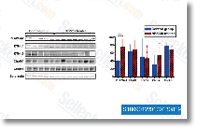The mesenchymal cluster overlaps that has a previously reported claudin low breast cancer subtype also characterized by loss of epithelial dieren tiation, an intense immune inltrate, and cancer stem like characteristics. Working with TNBC cell lines and xenografts, Lehmann and colleagues connected these clusters with particular therapeutic vulnerabilities. Using these expression signatures for treatment method selection and predic tion of response remains for being established. Importantly, a lot of of these subtypes or TNBC clusters seem analo gous to these described by Curtis and colleagues. Numerous alterations identied during the research reviewed right here lie in pathways which have been previously explored for drug advancement. Perhaps the biggest challenge to producing new therapeutics towards these commonly altered pathways lies in understanding the biological functionality of those mutations.
May be the alteration a driver of an oncogenic phenotype The presence of an alteration doesn’t imply oncogene dependence or therapeutic sensitivity. Does the mutation confer gain of function, reduction of perform, discover this info here or perhaps a new functionality altogether Assistance for clinical focusing on of those alterations will need in depth in vitro and in vivo experimentation to comprehend whether or not and the way the mutation functions biologically. Implications for clinical trials and care The wealth of information produced during the context of the studies presented should pave the way for more genotype driven trials with targeted therapies. Probable markers of sensitivity and resistance to targeted agents is usually examined with the bench to the basis of these ndings.
However, the use of these biomarkers in investigational clinical trials must be approached cautiously. As an example, really should only individuals individuals harboring a tumor with mutations in the PI3K pathway be considered for trials with PI3K BIBW2992 Afatinib inhibitors Though preclinical information support this notion, the complexity in the cancer genome as demonstrated by the reviewed scientific studies might circumvent this simplistic strategy. Sufferers who might benet in the targeted treatment but lack lesions within the targeted pathway could possibly be missed on the basis of the lack of in depth information of the many molecular lesions dysregulating such a pathway. Alternatively, pathway activation without direct mutation could portend a more plastic target, much less addicted towards the pathways output and hence far more in a position to evade inhibition.
A different important implication for clinical trials and biomarker studies could be drawn in the examine by Shah and colleagues, who examined clonal frequency of genomic alterations in TNBC. Given the regional hetero geneity present while in the tumors, also demonstrated in other research, therapeutic target identication  becomes difficult. Sampling with the tumor carried out from a cross area from the entire specimen most likely gives the very best representation of the many lesions and alterations present.
becomes difficult. Sampling with the tumor carried out from a cross area from the entire specimen most likely gives the very best representation of the many lesions and alterations present.
IKK signal
IKK is an enzyme complex
